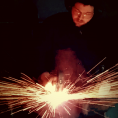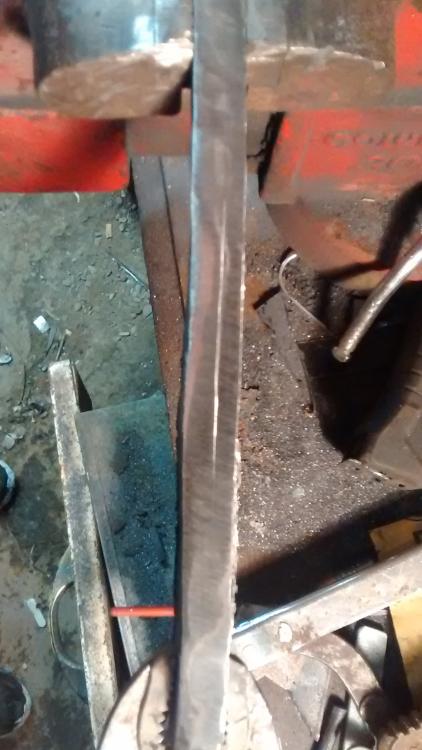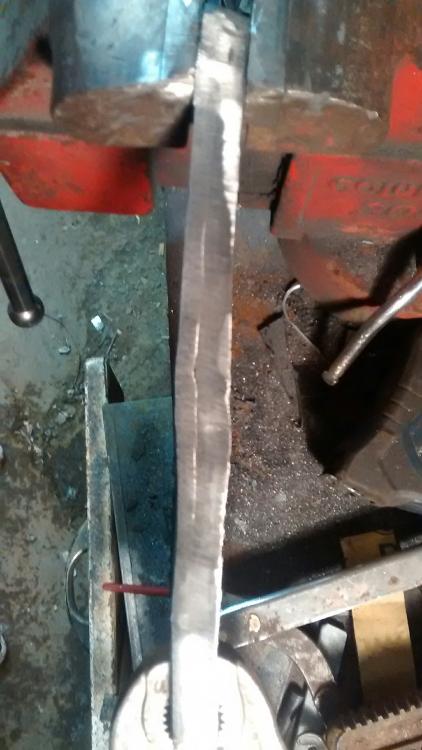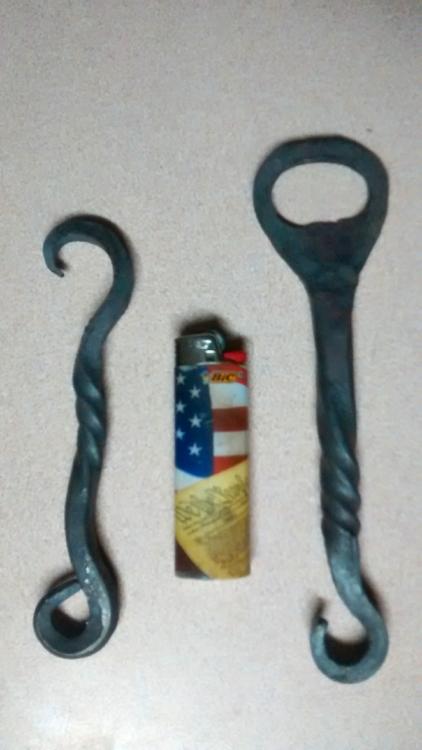-
Posts
733 -
Joined
-
Last visited
Content Type
Profiles
Forums
Articles
Gallery
Downloads
Events
Everything posted by Will W.
-
The micarta looks like it came out nice. Well done. Even if you can't save a whole lot doing it yourself, you can always have the added benefit of saying you made everything on the knife yourself, and making it exactly how you want. The knife looks nice as well.
-
Hot cut chisel sort of edge or cold chisel sort of edge?
-
C-1 That's basically what I was saying. Could have been worded better though.
-
Just as a reference point, I've played with a lot of pallet strapping, which after hardening usually bends to about a 45-50 degree angle before snapping, so it will harden but is not what I would call knife steel. Basically what jhcc said, just because it breaks doesn't mean it is great steel. If you can barely bend it to an angle at all before snapping, now your dealing with some decent steel.
-
Frosty That's interesting. Thank you for the detailed post. It would seem then that there is just enough chromium in there to cause an issue, but not enough to solve said problem. I suppose, given my lack of experience, I should definitely do more research on Damascus, find easier to weld alloys, and stop just going for it near-blindly. Again, thanks for taking your time to reply. It is appreciated. Jackdawg I tried to weld the delam back together, but it didn't take, even after several attempts. I suspect there is scale in there. I may try to open it back up, clean it, and fix it, but at the moment, my confidence in my welding abilities is yet again shaken. The fact that all seemed well (even after ground flush) until I began drawing it out is proof that my welds were weak, at least in that particular spot.
-
Frosty Thanks for the info. So, i am curious. If the chrome oxide is to blame, why is it that 5160 can be welded to different alloys? If the chrome oxide still forms, it should make it difficult to weld period, right? And what about stainless for that matter? People have welded stainless in billets before, and that has way more chromium in it. I'm not trying to deny or challenge any of your knowledge, these are genuine questions. And I think I will just find better alloys to work with, rather than use dangerous fluxes like those. JHCC I read most of that discussion, actually. Steve also mentions the flourine flux that Frosty was talking about in that one. He must have some REALLY good ventilation to be confident in working with that stuff.
-
Did some research on it. Seems like everybody, on various sites, is indeed saying it's hard to weld to itself, but nobody has a clear reason why. Stainless has way more chromium, and has been welded in billets, and likely to itself. Not entirely sure though, I'm no expert metallurgist. I also read that welding some 10 series steels (like i did) to 5160 can cause problems due to differing contraction rates, though it depends on the alloy. Cpuldnt find much on 5160 and 1075 though. Definitely learned a whole lot from this! Thanks for the responses everyone. I'll give it a go at fixing the billet tomorrow. Maybe it will work, or maybe I'll have a nice paperweight and one more lesson learned!
-
I do have some more 1075 laying around I believe. I may throw one in, assuming all goes well. I'm not positive on if there is scale in there. I stopped forging on it the second I noticed the delamination for that very reason. I really did beleive I had it up to temperature the entire time I was welding it. Initially ground down the sides and it was spotless as well. Nothing is a guarantee I guess. Any idea why 5160 doesn't like to weld to itself? I've never heard this. I'm not denying it, I'm just curious.
-
Good day. I welded this billet up the other day, all seemed well, and today i was in the process of drawing it out to cut, fold, weld, etc. when it developed a nasty delamination. It appears to go all the way through, right in the center of the billet, of course! The billet is currently 8-1/2" long, and the delamination *appears* to be about 3 inches. My question; if I attempt to cut fold and weld the two halves (which will both have a partial delamination) what are the odds that it will close itself back up on both pieces? Is it not worth my time to continue with? Should I just take the solid steel on the edges and continue with those? Probably won't be enough for a knife like I had planned, but still usable. In fact, this makes me question the integrity of the whole billet. The edges *seem* good. Sorry for the bad pics. All I have is my phone. If it makes a difference, the billet is alternating layers of 5160 (3) and 1075 (2), five layers in total. Thanks in advance.
-
Why weld another one on top of the first one? I see no advantage to this. This seems detrimental to me actually, as it will prevent you from building a proper size and shape fire. Plus having it open, you wont need to cut part of the drum out to pass through longer projects. I think the good old K.I.S.S. rule applies here. I can't believe I'm actually typing this (Frosty, what have you done!) but if you add a more precise location to your profile, you may be able to find someone on this site close to you who can help. Exact addresses are not necessary, but central, western, eastern? Hands on experience trumps everything. There are a few topics here about brake drum forges iirc. It never hurts to ask questions, but definitely check the forum before asking. You may find that someone already asked, and got an answer to, your question. And heck, you may even learn something that you didn't even know you needed to learn! I know I have a time or ten before.
- 14 replies
-
- forges
- knifemaking
-
(and 1 more)
Tagged with:
-
I'll keep that in mind, JHCC. Thanks.
-
I built a brake drum forge about a year ago and have been using it almost daily since. In my opinion, brake drums are a little too wide and shallow. It makes building a deep fire for things like welding a little tricky, though welding is far from impossible in them (I do it often in mine.) And you sometimes end up burning more fuel than needed, depending on your project, due to the width. All of these things are dependant on the drum you use though. Mine is 10" round. Works very well for making knives, I think. I rarely make knives with blades over 10" so getting an even heat for quenching is not difficult. All in all, I think they make decent firepots. I also burn charcoal, and it is a great fuel, I believe. It burns up faster than one would expect, so be ready for that. It provides excellent heat though, and you can burn steel away if you're not careful. I would also recommend staring out learning the basics. I'm still pretty new as well, and I wish I listened to the more experienced bladesmiths on this site about learning the basics first. I've messed up many would-be knives because I didn't know what I was doing. Learn how to draw out, upset, punch holes, flatten steel, take out a bend etc. before you just go at it. Its important to be able to accurately predict how the steel will move and act proactively instead of reactively. It will help you, I promise. Oh, yes, and in the all too common words of the experienced guys here, pack a lunch, grab a cold drink, and READ THE INFORMATION ON THIS SITE! There is so much knowledge readily available to you here. Good luck.
- 14 replies
-
- forges
- knifemaking
-
(and 1 more)
Tagged with:
-

Show me your Bottle Openers!
Will W. replied to Arbalist's topic in Blacksmithing, General Discussion
Just made these tonight. Nothing too special but surprisingly, the one on the left works with no adjustment needed. I was sure it would have to be tested and tweaked. Awesome design Vaughn! -
Surprisingly, Neil, I have none of that around. Looks like I may have to make a trip to the local craft store to pick up some clay (or head down to the river bank with a shovel and a bucket lol)
-

Forge fuel
Will W. replied to Sacred Steel Forge's topic in Solid Fuels: Coal, Coke, Charcoal, Wood, etc
Probably already mentioned, but if you're interested in making your own lump charcoal, there are several topics here on designing a charcoal burner, retort, or "maker" they're sometimes called. Most consist of a steel drum or two and are easy to make. Charcoal does not take much air to forge with, compared to coal anyways, in my experience. I usually crank pretty slowly on my blower, and I can reach forging heat plenty fast. Until you have you "hand bellows" built, I recommend listening to C-1. A simple piece of tape could cut your air flow back to where it is manageable.- 35 replies
-
- coal coke
- burquettes
-
(and 1 more)
Tagged with:
-
Awesome tutorial, thank you for posting.
-

Forge fuel
Will W. replied to Sacred Steel Forge's topic in Solid Fuels: Coal, Coke, Charcoal, Wood, etc
A little piece of wisdom a dear friend gave me that I believe is prudent to pass on: with almost everything in life, things can be done fast, things can be done cheap, and things can be done correctly. You get to pick two of these. As mentioned, I would switch to lump charcoal as well. I enjoy working with it personally, it's easy to light (compared to coal) and it's HOT! You can burn steel away if your not careful.- 35 replies
-
- coal coke
- burquettes
-
(and 1 more)
Tagged with:
-

Can You Tell Me Number of This Champion Forge
Will W. replied to satonhat's topic in Solid Fuel Forges
I second everything little blacksmith said. -
I've heard of that, C-1. Never tried it myself though. I think it would be hard to do precisely though, clay is a little too maleable, it would seem. Like I said though, never tried it.
-
Thanks for the quick replies guys. That's actually what I was hoping to get to, about 10 inches. I appreciate the help, and I will definitely be recording these formulas for future note.
-
Good day. I just finished the initial welding on a damascus billet I'm working on. The welding went suprisingly well! The piece is currently 1" thick by 3/4" wide by 6-1/2" long. I want to draw it out to about 1/2" thick by 1 inch wide by ??? long before cutting, folding, and welding again. I'm wondering, is there any sort of mathematical formula that I can use to figure out roughly how long the piece will be given the current and desired dimensions? I realize this is very dependant on several variables, but I'm looking for more of an approximation than anything. I also realize that I could just do it, and what I have is what I'm left with, but this would be useful information for many situations. I did search for this question, and the little I found was more about "I know what finished dimensions I want, how much metal do I need?" Rather than how much I will end up with given what I have. Thanks in advance.
-
I have no experience whatsoever with wrought, but it sounds like it could have been cast iron, IMO. I second that, Daswulf, pictures would help.
-
Thanks for the idea Thomas. Every time I have tried to do it so far, the two ends either slip off of each other (despite me barely tapping it, and even when the overlap is pre flattened) or they get burnt, or, more commonly, it losses welding heat in about half a second flat. I'll try that next time I have the forge going, and report back.
-
Had not thought about that. Thanks for the tip guys. I'll give it a try.



